Once upon a time, I was able to report three or more new Special Light-Sport Aircraft every month. That was more than a decade back when the pace of new arrivals seemed faster than a rocket parachute deployment. Lots of airplane developers from all over the globe wanted a piece of this promising LSA action with its greater freedoms and breathtaking pace of innovation. New models were announced with regularity.
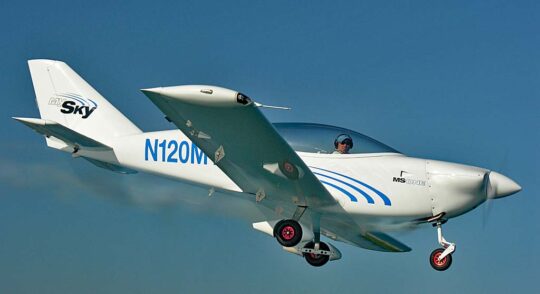 For the past few years that torrid pace slowed… just as it has in every other industry I’ve examined. However, in aviation it is uncommon for a good airplane to actually disappear forever. Designs worth their avgas often manage a come-back, a term meant to show a return to market for a flying machine some may have written off earlier.
For the past few years that torrid pace slowed… just as it has in every other industry I’ve examined. However, in aviation it is uncommon for a good airplane to actually disappear forever. Designs worth their avgas often manage a come-back, a term meant to show a return to market for a flying machine some may have written off earlier.
Here is such a story.
MySky MS-One
From the day I laid eyes on it, I liked the tandem seating, comfortable cockpit, and sturdy construction of MySky’s MS-1 or MS-One. This American clean-sheet creation featured a shapely nose cowl, sidestick control, optimal wheel pants — consisting solely of fore and aft fairings — and strong performance with a 120-horsepower Jabiru 3300 engine.
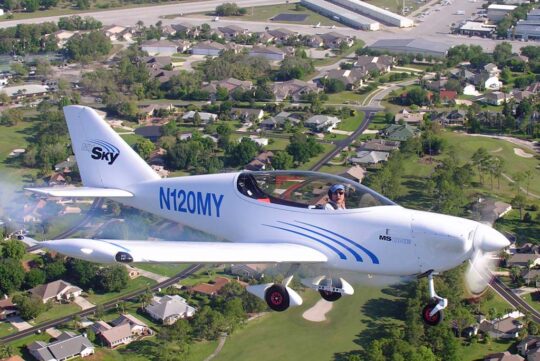 One thing MS-1 did not have going for it: the design arrived to the party amidst so many other new designs that it was easy to get lost in the crowd. Proprietor and principal investor Dieter Canje wisely set the project aside while the dust cleared.
One thing MS-1 did not have going for it: the design arrived to the party amidst so many other new designs that it was easy to get lost in the crowd. Proprietor and principal investor Dieter Canje wisely set the project aside while the dust cleared.
Now it’s back and with a splurge of innovation planned.
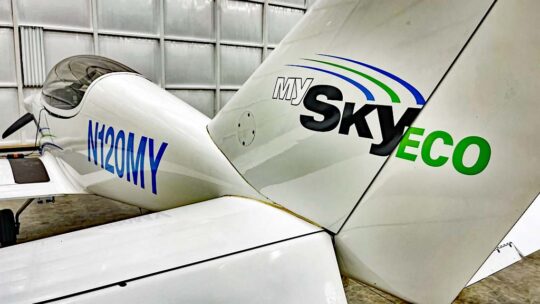
The backstory is worth exploring. Let’s answer a few questions.
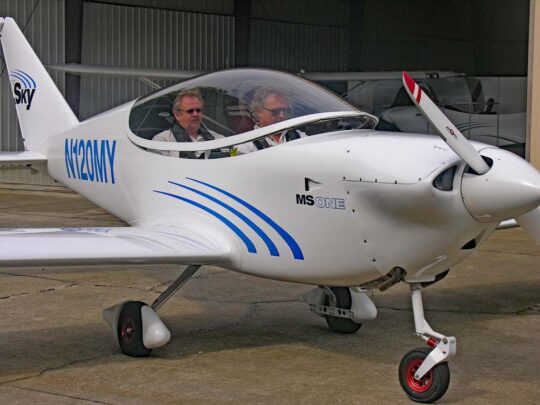
MS-1 was also meant to be a flight trainer from day one, the company said. “But the stringent weight limitation did not allow us to beef up the design to make it really durable enough for daily operation in a commercial flight school operation.”
Reconfiguring MS-1
Several years went by and the airplane flew but development was put on a back burner until better regulations arrived. During this period, Dieter and associates kept thinking about MS-1’s potential.
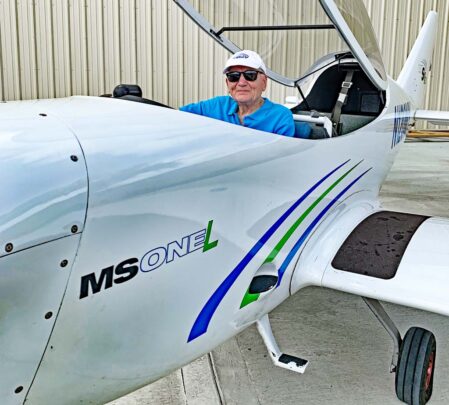
“In 2022, environmental concerns are taken much more seriously by a large percentage of the general population,” believes Dieter. “If we in the aviation industry, be it light or commercial aviation, cannot demonstrate that we are doing our part to mitigate our environmental impact, we will run into problems. It is in our own interest to do something to reduce the environmental footprint of aviation as soon as we can.”
This is where MySky ECO, Inc., comes into play with a 5-step program with the final goal to create a totally emission-free aircraft.
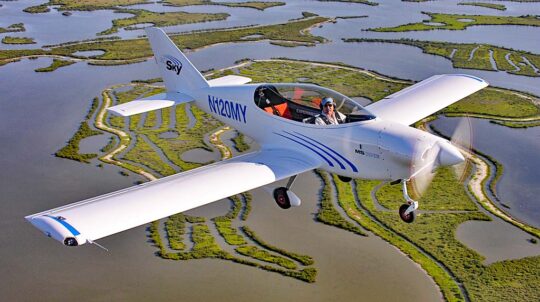
“We will modify the existing prototype and install the Rotax 915 iS with electronic injection, turbocharger, intercooler, double ECUs and a FADEC system,” Dieter envisioned. “It will have a single lever engine control system. No more manual mixture control. This is automatically done by the Engine Control Unit (ECU).” Single lever control reduces the pilot’s workload during all phases of flight while optimizing fuel consumption. The pilot only moves the throttle as desired; the system handles the details.
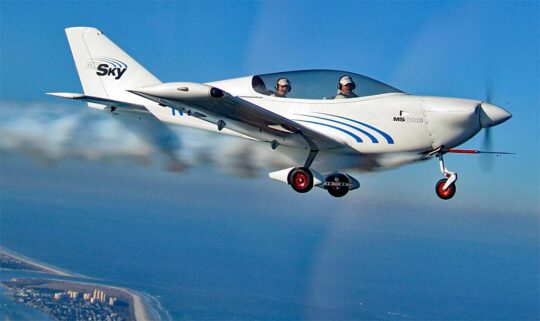
“In our modern tandem, the instructor will be sitting in the back,” said MySky. “The student has full visibility. Communication is not a problem anymore because we are all wearing headsets today. But there is one major advantage to instruction in a tandem: the student ‘feels’ from day one like he or she is flying solo.”
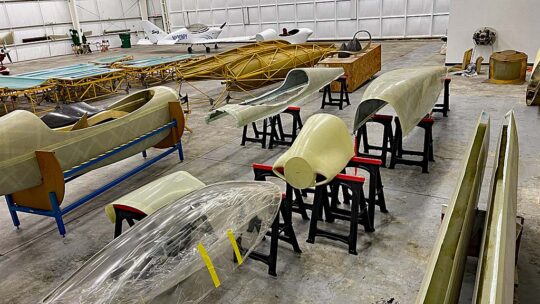
In their spacious facility, MySky is setting up shop for production of MS-1L.
Will there be more modifications to the MS-1 design? — “Once we have the new engine cowling design finalized, we will redesign the current fiberglass structure to an all-carbon design,” Dieter forecast. “Fifteen years ago, carbon was much more expensive and not as readily available.”
Additional planned modifications include increased dihedral, a modified horizontal tail, and new wing tips. “As long as we were limited to 120 knots we did not need better performing wing tips, said MySky. “We were too fast already. Now, with Mosaic rules coming, we can expect to have a less restrictive speed limit so better wing tips make sense now.”
Electric, Hydrogen, and Beyond
“While we are finalizing MS-1L, we will being designing and engineering work on MS-1e,” predicted Dieter. “This will be our pure electric aircraft.” Because batteries presently have energy densities substantially less than conventional fuel, a pure electric airplane only makes sense for the flight training industry, believes MySky.
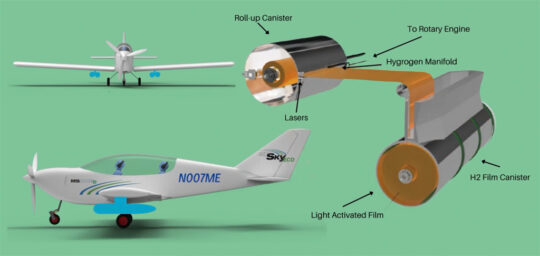
“Our MS-1r concept is a next evolutionary step, a rotary engine driving the propeller and using Jet-A as its fuel,” said MySky representative Grant Desmarais. “Rotary engines were notorious for their poor efficiency and bad exhaust emission values. Both problems are connected. Solutions to solve both could arrive with one stroke: laser ignition.”
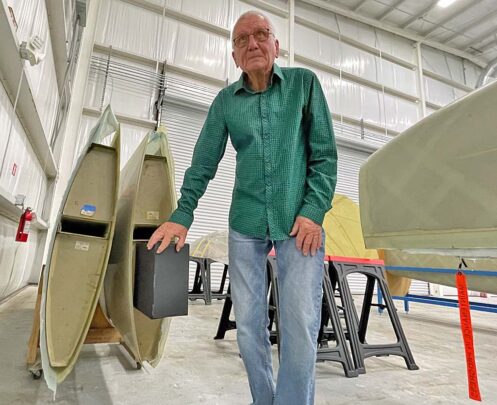
MySky boss Dieter Canje shows a mock battery placement in the wings. Like wingtip fuel tanks, load borne in the wings is desirable.
MS-1r H is the final step in MS-1’s development journey. “A rotary engine lends itself to run on hydrogen, much more than a piston engine,” explained Grant. “We are working on a solution where the hydrogen is not stored in high pressure tanks at extremely cold temperatures. We will store the hydrogen in a solid state. Hydrogen stored this way will not be flammable or explosive. It will be temperature stable up to 750 °F.”
The fresh ideas are exhilarating. While development progresses on the eco designs, many may be interested in the Legacy model. MySky’s MS-1 with Rotax’s 915iS would make a potent performer for enthusiasts and a good Technically Advanced Aircraft (TAA) design that flight schools might embrace.
ARTICLE LINKS:
- MySky and MS-1, all content on this website
- MySky Aircraft, factory website
- You can assist MySkyEco’s project for cleaner aviation
- Rotax 915iS engine, article on this website
The following video shows MySky’s longer-term vision of cleaning up the skies. Most pilots can see that such improvements are far more likely on light aircraft aircraft than, say, airliners.
This vintage video was recorded 12 years ago but provides a good review of MySky’s MS-One. (Please remember that video and microphone quality were not as good as today’s hardware. The audio is a bit noisy but you can hear all words easily.)



Yes, I believe that Mosaic put a stop to the development of new LSAs in the USA.
But I see the problem more in the original LSA rules. In my view, they were too limiting. In the case of MS-1, we would have had to adjust the propeller to a speed which would make the airplane much less economical – just to stay within 120 knot limit. In other cases, the weight limit did not allow for decent cabin size, useful load and the durability of components needed for the operation of an LSA in the demanding flight school environment.
Mosaic is going to solve these problems. We will be able to produce an aircraft durable and robust enough for flight schools. And we will be able to use modern technologies, like FADEC.
I think new LSAs … will be much better and more useful airplanes.
What kind of rotary engine? Wankel?
Yes. It will be a somewhat modified version of the Wankel design.
The Wankel design has great advantages and – unfortunately – equally great disadvantages. Poor efficiency and equally poor emissions are the most important ones. Interestingly, these disadvantages go away once hydrogen is used as fuel.
As Brad Boyer commented, there is one that we will have to live with: higher internal thermal losses compared to conventional piston engines. But we believe we can handle that, especially as we will carry the hydrogen in solid state and not in high pressure tanks.
I’ve heard that the biggest problem with using hydrogen fuel as a green fuel is that the only cost effective ways to product it in bulk uses natural gas and releases a lot of greenhouse gases even though the hydrogen fuel itself burns cleanly. Is it expected that there will be a way to product it in bulk from renewable resources by the time that this design takes off?
Sure would be nice if these reviews indicated prices as well. When AOPA features a plane, they list base price and price as tested. Allows me to quit wishing right away.
Quoting a price for an aircraft on the market is easy. MS-1 is not on the market yet. However, almost certainly it will be a lower number than aircraft commonly reviewed in Pilot.
Having over a decade in H2ice technical development, I can tell you that rotaries are not nearly as efficient as piston H2ice.
Even with advanced ignition, the heat losses of any rotary designs on the market are too high. It simply is a geometric challenge of surface/volume in the combustion chamber.
I wish you luck on your ambitious h2 plans, particulates are the more difficult one for storage and infrastructure.
Given then challenge of storage, you can’t afford an inefficient engine. Which is why I’m mentioning the heat loss deficiency of rotaries.
Thank you for your obviously well-founded comment!
We know about the higher heat transfer losses of a rotary engine compared to a conventional piston engine. But what about the pre-ignition challenges when hydrogen is used as fuel for an Otto-cycle piston engine? Is there the ultimate solution yet?
Regarding storage of H2, we are not even considering high pressure or ultra-low temperature storage. These solutions may work for large aircraft. But in small aircraft, weight and space limitations don’t allow for that. We will use solid state storage, using specifically designed cannisters for our purpose. More about this technology here: https://plasmakinetics.com/
Regarding the infrastructure, we are planning to develop decentralized production of Green Hydrogen from photovoltaic panels and filtered rainwater. Example: We expect to generate 15KG of H2 from the roof of our hangar – per day on average. Admittedly, this is the average for Florida.
I don’t want to downplay that there are many challenges. But we need to start somewhere.
I dunno. These guys sound a lot more like futuristic inventors that need investors than current airplane marketers. Plenty of planes came onto the market when MS first tried. Many succeeded. One problem I see with these plane companies is that they suck at marketing their product. Especially online. Just take a look at a random pick of current web sites. They want $100,000, $200,000 or more of your money but they cannot even design a decent web presence? Not only these guys, but a ton of the current plane dealers and manufacturers. Their web site is no exception… everything is from 2010 or thereabouts. They show a 915 in the video above, but their web site is still touting the Jabiru. They knew you were running a story about them, but they had no time to update the site to reflect the new generation design? The videos are more about saving the climate than about the airplane. If they think we pilots are more concerned about climate change than we are about the value offered by a design, they will find themselves not getting Gen 2 to the market, too. I hope the depositors back in 2010 were made whole.
Otherwise, it is a nice looking plane.
You are right, at this point we are not marketing MS-1L yet. It is still under development and will not be marketed until the new FAA Mosaic rules are in force or – at least – finalized.
Have you been on the old website? Have you tried the new one: http://www.myskyeco.com
Yes, we are a research & development project. And once we are ready for sales, our intention is to bring the best value to pilots, not only regarding the airplane itself but also considering availability and economy of its fuel.
BTW: There were no depositors in 2010… except me. And thank you for the “nice looking plane”.
“Once upon a time, I was able to report three or more new Special Light-Sport Aircraft every month. That was more than a decade back when the pace of new arrivals seemed faster than a rocket parachute deployment. Lots of airplane developers from all over the globe wanted a piece of this promising LSA action with its greater freedoms and breathtaking pace of innovation. New models were announced with regularity.
For the past few years that torrid pace slowed…”
One word explains the lack of new USA designed and built SLSAs since ~2014: Mosaic
No one in their right mind, whose market is only the US, would start a new effort once they found out about the ‘new’ 3,600-pound limit for the next generation LSA. Well, it will not be 3,600# pounds, as we all know now. But Mosaic LSA will be significantly different from the current crop of circa 2014 LSAs. Yes, some of the foreign companies are moving ahead with their version of the Mosaic LSA, but they have their government’s equivalent of the FAA behind them.
Mosaic has killed the LSA market for U.S. companies. Not many US based LSA companies have the ability to actively and successfully market their products in Europe or Australia, for example.
Just my 2 cents worth…
Yes, I believe that Mosaic put a stop to the development of new LSA in the USA.
But I see the problem more in the original LSA rules. In my view, they were too limiting. In the case of MS-1, we would have had to adjust the propeller to a speed which would make the airplane much less economical – just to stay within 120 knot limit. In other cases, the weight limit did not allow for decent cabin size, useful load and the durability of components needed for the operation of an LSA in the demanding flight school environment.
Mosaic is going to solve these problems. We will be able to produce an aircraft durable and robust enough for flight schools. And we will be able to use modern technologies, like FADEC.
I think new LSAs … will be much better and more useful airplanes.
Dieter, I agree that the FAA adopted the EASA specifications for what we call the LSA category without any apparent modifications. Big mistake, but that says more about the FAA than anything else. Not writing the LSA rules to include existing trainer aircraft, including C-172s and Cherokees for example, was prudent. The FAA just rubber stamped EASA’s rules.